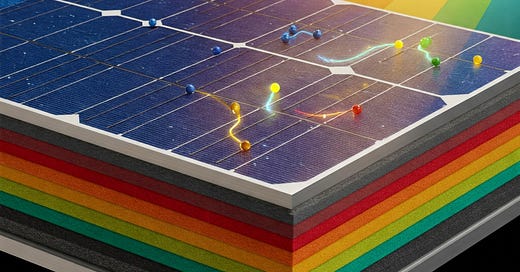Silicon & Sunlight: Decoding the Solar Cell
Exploring the intricate science behind how light becomes electricity.
Let's break down what happens inside a solar cell when light shines on it, and how that light turns into electricity.
The Magic of Sunlight:
Sunlight is made up of tiny packets of energy called photons. Think of them like little bullets of light.
When sunlight hits a solar cell, these photons bump into the atoms that make up the cell.
Energizing the Atoms:
Solar cells are made of special materials, usually silicon. There are different types of silicon used, like crystalline silicon and amorphous silicon, each with slightly different properties. But they all work on the same basic principle. When a photon hits a silicon atom, it gives the atom some energy.
This energy knocks loose tiny particles called electrons from the silicon atoms.
Creating a Flow:
These freed-up electrons start moving around inside the solar cell. Imagine the solar cell having a sort of "electrical hill." When the photon hits and the electron gets energized, it's like pushing a ball to the top of the hill. It wants to roll down. The design of the solar cell directs this "rolling down" (the flow of electrons) in a specific direction.
This movement of electrons is what we call an electric current. It's like water flowing through a pipe.
From Sunlight to Electricity:
The solar cell is designed to capture this electric current.
The current flows out of the solar cell through tiny wires connected to it. These wires are then connected to whatever the solar cell is powering, completing the circuit. This current can be used to power things, like lights or appliances.
Important Note: Electrons are Recycled!
Electrons do get freed up when light shines on a solar cell. However, it doesn't mean the silicon loses all its electrons over time. Here's why:
Electrons are Recycled: The electrons that are freed up don't just disappear. They flow through the circuit and eventually return to the silicon atoms. It's like a continuous loop. Think of it as water flowing through a pipe and back into a reservoir.
Silicon's Stability: Silicon is a very stable material. It doesn't easily lose its atoms or undergo significant changes that would cause it to lose all its electrons.
The Role of Light: The light energy is what causes the electrons to move, not the silicon itself. The silicon acts as a conductor and facilitator for this process.
Think of it like this: Imagine a group of people (electrons) sitting on chairs (silicon atoms). When music (light) starts playing, some people get up and dance (move), creating energy. But they eventually sit back down in their chairs. The chairs don't lose any people in the process.
So, the silicon in a solar cell doesn't lose its electrons over time. It continues to facilitate the flow of electrons as long as light shines on it. This is why solar panels can last for many years, typically 25-30 years or even longer, without losing their ability to generate electricity.
In Simple Terms:
Imagine a solar cell like a tiny dance floor for electrons. When sunlight (the music) hits the dance floor, it makes the electrons (the dancers) start moving. This movement of electrons is the electricity we use. And just like dancers return to their seats after a dance, the electrons return to the silicon atoms, ready for the next "song."
The Tech Behind It:
The process we just described is based on something called the photovoltaic effect. This is a scientific principle that says certain materials can convert light directly into electricity.
Solar cells are carefully designed to make this process as efficient as possible. They use special layers of materials to help the electrons flow in the right direction and to prevent them from getting lost.
Key takeaway: Solar cells use the energy from sunlight to knock electrons loose from atoms, creating an electric current that we can use to power our world. And the silicon in the solar cell doesn't get used up in the process!



